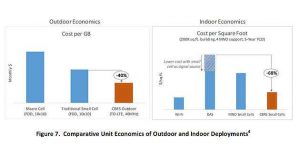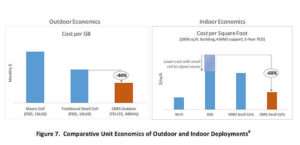
Tier one mobile operators in the United States have, on average, 130MHz of licensed spectrum. Others, like cable operators and enterprises, mostly use unlicensed spectrum to provide wireless connectivity. All of them are entering the fourth Industrial Revolution era where digital automation drives the need for more capacity and higher reliability. New spectrum, new deployment models, and more efficient ways of using that spectrum are required sooner rather than later.
CBRS (Citizens Broadband Radio Service) comes to the rescue! The world’s first and unique three-tier shared spectrum promises the most efficient approach to fill this need and create new business opportunities.
Up to 150MHz of favorable mid-band spectrum at an expected low spectrum acquisition cost and enhanced mobile coverage and capacity reduce the monthly cost of gigabytes of data by 40% compared to a traditional small cells outdoor deployment. The Cost per Square Foot for indoor applications is reduced by up to 68% compared to technologies of today.
Figure 1: Comparative Unit of Economics of Outdoor and Indoor Deployments
(Source: Mobile Experts white paper “CBRS: New Shared Spectrum Enables Flexible Indoor and Outdoor Mobile Solutions and New Business Models”)
With the support of all four major mobile operators in the U.S., and the existing use of 3.5 GHz as an LTE band in other parts of the world, the device ecosystem support for the 3.5 GHz CBRS band and technology is more likely than ever, and the broadening ecosystem is expected to bring scale advantages and consequently low-cost solutions.
But don’t take my word for it. Learn more about the tangible value of CBRS from the white paper written by Mobile Experts’ Kyung Mun,“CBRS: New Shared Spectrum Enables Flexible Indoor and Outdoor Mobile Solutions and New Business Models”. It offers detailed insights on what CBRS is and how it works, CBRS use cases and business models, and the comparative economics of CBRS.

